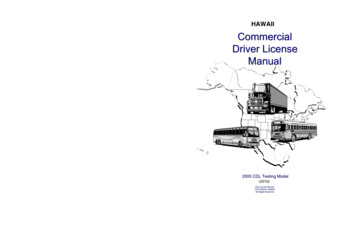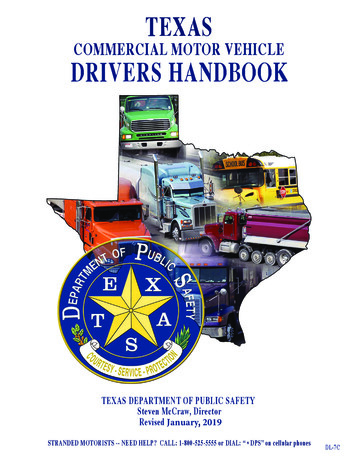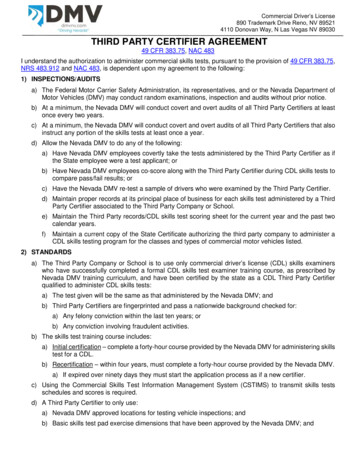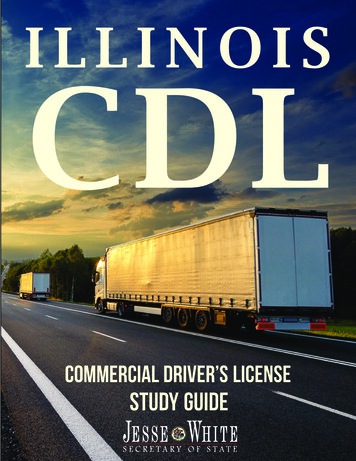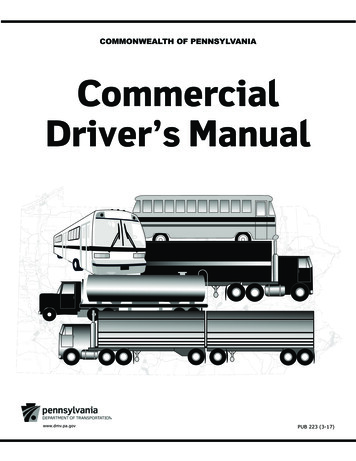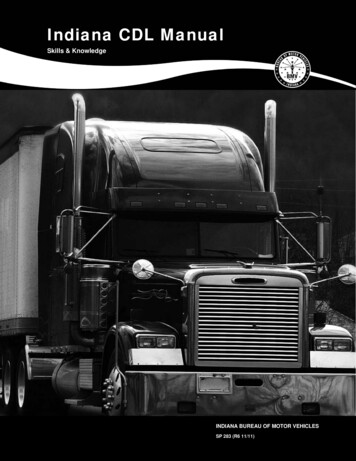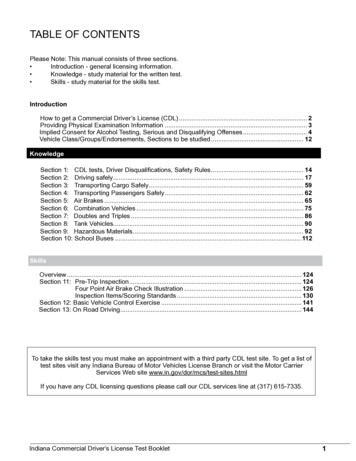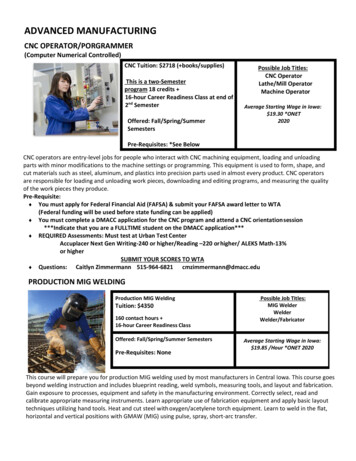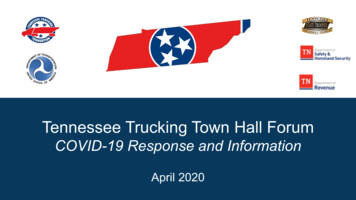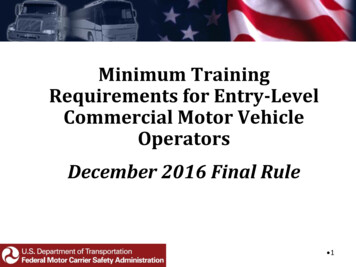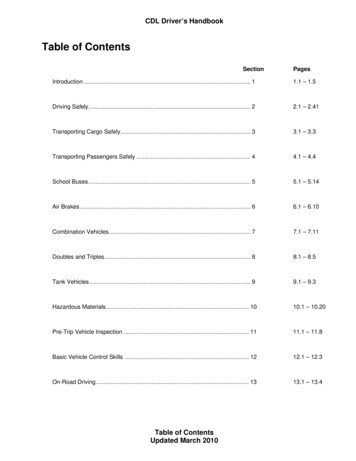
Transcription
CDL Driver’s HandbookTable of ContentsSectionPagesIntroduction . 11.1 – 1.5Driving Safely. 22.1 – 2.41Transporting Cargo Safely. 33.1 – 3.3Transporting Passengers Safely . 44.1 – 4.4School Buses. 55.1 – 5.14Air Brakes . 66.1 – 6.10Combination Vehicles. 77.1 – 7.11Doubles and Triples. 88.1 – 8.5Tank Vehicles . 99.1 – 9.3Hazardous Materials. 1010.1 – 10.20Pre-Trip Vehicle Inspection . 1111.1 – 11.8Basic Vehicle Control Skills . 1212.1 – 12.3On-Road Driving . 1313.1 – 13.4Table of ContentsUpdated March 2010
CDL Driver’s Handbook Firefighting Equipment. Necessary to the preservation of life and property or the execution ofemergency governmental functions; emergencyequipment such as a fire truck, hook and ladder,foam or water transporter or other vehicles usedonly in response to emergencies are included inthis exemption. Those employed as a volunteer orpaid firefighting organization are included in the exemption.Section 1INTRODUCTIONThis Section Covers Commercial VehiclesCDL Vehicle ClassesEndorsementsRestrictionsExemptionsCDL TestsDriver DisqualificationsOther Safety Rules Emergency Snow Plowing. During declared emergency snow removal operations, non-CDL holdersmay operate snowplow vehicles. The ColoradoState Patrol (CSP) determines when an emergencysnow condition exists.The information in this handbook is to assist thecommercial motor vehicle (CMV) driver in obtainingtheir Commercial Driver’s License (CDL). If youhave questions on traffic rules, signs, point systems, driving standards, or identification requirements, this information is available in the Colorado’s Regular Driver’s License Handbook.You must have a CDL to operate: Any motor vehicle with a Gross Vehicle Weight Rating (GVWR) of 26,001 pounds or more. Any combination of vehicles with a gross combination weight rating (GCWR) of 26,001 pounds ormore provided the gross vehicle weight rating(GVWR) of the vehicle(s) being towed is in excessof 10,000 pounds. Any vehicle that is designed to transport 16 or morepassengers, including the driver. Any vehicle transporting hazardous material and isrequired to be placarded in accordance with 49Code of Federal Regulations (CFR) Part 172, Subpart F.The following vehicles are exempt from the CDLrequirements. Commercial Motor Vehicle does notinclude: CMVs operated by military personnel for militarypurposes. Any farm vehicles: Controlled and operated by a farmer; Used to transport agriculture products, farm machinery, or farm supplies to or from a farm; Used within 150 miles of the person’s farm; Not used in the operation of a common or contract motor carrier. Recreational Vehicles. When used for recreational purposes, a motor home which truck or motor home is used exclusively for pleasure, enjoyment, other recreational purposes, or familytransportation of the owner, lessee, or occupantand is not used to transport cargo or passengersfor profit, hire, or otherwise in any business orcommercial enterprise.CDL OVERVIEW1.1 – CDL VEHICLE CLASSESClass A—Combination Vehicles. Any combination of vehicles with a gross combination weightrating (GCWR) of 26,001 pounds or more providedthe gross vehicle weight rating (GVWR) of the vehicle(s) being towed is in excess of 10,000 pounds.Class B—Heavy Straight Vehicles. Any singlevehicle with a GVWR of 26,001 pounds or more, orany such vehicle towing a vehicle not in excess of10,000 pounds GVWR.Class C—Small Vehicles. Any single vehicle, orcombination of vehicles, that meets neither thedefinition of Class A, nor that of Class B, but that iseither designed to transport 16 or more passengers, including the driver, or is used in the transportation of materials found to be hazardous forthe purposes of the Hazardous Materials Transportation Act and which require the motor vehicle tobe placarded under the Hazardous MaterialsRegulations 49 CFR part 172, Subpart F.Representative Vehicle. For purposes of taking theskill tests, a representative vehicle for a givenvehicle class is any commercial motor vehicle thatmeets the definition of that vehicle class. A trucktractor is designed to operate with a towed unit(s),typically a semi-trailer and therefore could only beSection1 – IntroductionPage 1- 1
CDL Driver’s Handbookused as a representative vehicle when connected toa semi-trailer, for the Class A CDL.Relation Between Vehicle Classes. Each driverapplicant who desires to operate in a different CMVgroup from the one that his or her CDL authorizesis required to take and pass all related tests, except the following: A driver who has passed the knowledge and skilltests for a combination vehicle (Class A) may operate a heavy straight vehicle (Class B) or a small vehicle (Class C), provided that he or she possessesthe required endorsement(s); and A driver who has passed the knowledge and skilltests for a heavy straight vehicle (Class B) may operate any small vehicle (Group C), if he or she possesses the required endorsement(s). A driver that operates vehicles with air-over hydraulic brake systems or air-assisted brake systems willnot be allowed to drive vehicles equipped with “full”air brake systems.CDL ENDORSEMENTSRemoving the Restriction L. To remove the airbrake restriction “L", the knowledge test on airbrakes and the skill tests in a vehicle equipped witha “full” air brake system are required.Removing the No/Trtcr/Trlr. To remove the notractor-trailer restriction, the driver must completethe appropriate knowledge test(s) and skill tests ina power unit with a GVWR of 26,001 pounds ormore, a towed unit with a GVWR of 10,001 poundsor more and a GCWR of 26,001 pounds or more.Legal Age: 18You must be at least 18 years of age to apply for aCDL Instruction Permit or to receive a CDL. Drivers18 through 20 years of age will be issued the “K”restriction to operate a CDL vehicle within theboundaries of Colorado.Medical ExaminationTo obtain the medical examination form you shouldcontact your employer, physician, or download theform at: http://www.csp.state.co.us/mcsap.html andhave a medical doctor certify the form.CDL Instruction PermitT – Double/Triple Trailers – a knowledge testP – Passenger – knowledge and skill testsP1 – passenger vehicle 26,000 lbs or lessP2 – passenger vehicle 26,001 lbs or moreN – Tank Vehicle – a knowledge testH – Hazardous Materials – a knowledge testS – School Bus – knowledge and skill testsX – Hazmat/Tanker CombinationIf you have an out-of-state driver’s license, youmust be issued a Colorado Regular Driver’s License before applying for a Colorado CDL Instruction Permit. The CDL Instruction Permit is requiredbefore the CDL Driving Skill Tests are administered.To receive the CDL Instruction Permit you must:CDL RESTRICTIONSK – Intrastate only. For individuals between theages of 18 through 20, or for individuals who donot meet the Department of Transportation (DOT)medical requirements but have been issued awaiver from the Colorado State Patrol (CSP) tooperate a CDL vehicle.L – Air brake restriction. If an applicant either failsthe air brake component of the knowledge test, orperforms the skill tests in a vehicle not equippedwith a “full” air brake system, the person is restricted from operating a CMV equipped with a“full” air brake system.No/Trctr/Trlr – No Tractor Trailer Operation. If anapplicant successfully completes the driving skilltests in a vehicle meeting the definition of Class Abut the power unit is under 26,001 pounds GVWRand the combination of power unit and the towedunit(s) is 26,001 pounds or more, the person isrestricted from operating a tractor-trailer. Have a Colorado regular driver’s license. Show acceptable legal presence documentation. Show acceptable identification. Be at least 18 years of age. Show proof of your Social Security Number. Show evidence of a current DOT medical examination certification. Clear Commercial Driver License Information System (CDLIS) and National Driver Register (NDR)record’s checks. Pass the required CDL Knowledge tests. Pay the Instruction Permit fee.The CDL Instruction Permit allows you to operatethe class of vehicle shown on the permit only whenyou are accompanied by a person who is at least21 years of age and holds a valid CDL of the sameclass of license or higher, with the required endorsements for the vehicle being operated. Theperson must be in the seat closest to the driver.Section1 – IntroductionPage 1- 2
CDL Driver’s HandbookCOMMERCIAL DRIVER LICENSE KNOWLEDGETESTSYou will have to take one or more knowledge tests,depending on what class of license and what endorsements you need. The CDL knowledge testsinclude: The general knowledge test is required for all applicants. The air brakes test is required if your vehicle has a“full” air brake system. The combination vehicle test is required if you wantto drive combination vehicles. The hazardous material test is required if you wantto haul hazardous materials or waste in amountsthat require a placard or any quantity of a materiallisted as a select agent or toxin in 42 CFR 73. The tank test is required if you want to haul a liquidor liquid gas in a permanently mounted cargo tankrated at 119 gallons or more or a portable tankrated at 1,000 gallons or more.Pre-trip Vehicle Inspection. You will be tested tosee if you know whether your vehicle is safe todrive. You will be asked to do a vehicle inspectionand explain to the tester what you are inspectingand how you know an item is in good, safe workingorder.Basic Vehicle Control. You will be tested on yourskill to control the vehicle in relation to other objects. You will be asked to move your vehicle forward, backward, and turn it within a defined area.These areas may be marked with traffic lanes,cones, and barriers. The tester will give you instructions on how each exercise is to be done.On-Road Driving Test. You will be tested on yourskill to safely drive your vehicle in a variety of trafficsituations. The situations will include left and rightturns, intersections, railroad crossings, curves, single or multi-lane roads, streets, or highways. Thetester will give you directions during the road test.Figure 1.2 details which sections of this handbookyou should study for each particular class of license and for each endorsement. The doubles/triples test is required if you want topull double or triple trailers.What Sections Should You Study?LICENSETYPEHazMatDouble/TripleTank Vehicle School BusClass CIf you pass the required knowledge test(s) and areissued a CDL instruction permit, you can take theCDL Skill Tests. There are three types of skill teststhat you will be tested on: vehicle inspection, basicvehicle control, and on-road driving. You must takethese tests in the type of vehicle for which you wishto be licensed. If you fail any portion of the skilltests, you must wait three days to be retested andall three skills must be redone. To schedule a retest, you can contact a CDL Third Party Testingunit.123456*78910111213Class BAuthorized CDL third party driving skill testing unitsadminister the CDL Skill Tests. A list of CDL ThirdParty testing units is located online RMV/1187080326147. You can contact a thirdparty CDL testing unit to schedule the skill tests. Ifyou need additional information, you can call 303205-5682.Sections to StudySKILL TESTSClass A The School Bus test is required if you want to drivea school bus to transport children to and fromschool or to and from school sponsored events.ENDORSEMENTPassenger The passenger transport test is required if you wantto drive passenger vehicles designed to transport16 or more passengers, including the driver. *Study Section 6 if you plan to operate vehicles equippedwith air brakes.Section1 – IntroductionPage 1- 3
CDL Driver’s Handbook1.2 – DRIVER DISQUALIFICATIONSSERIOUS TRAFFIC VIOLATIONSSerious traffic violations are:GENERAL excessive speeding (15the posted limit); reckless driving: improper or erratic lane changes;It is illegal to operate a CMV if your blood alcoholconcentration (BAC) is .04% or more. If you operate a CMV, you shall be deemed to have givenyour consent to alcohol testing. following a vehicle too close; and traffic offenses committed in a CMV in connection with fatal traffic accidents:You will lose your CDL for at least one year for afirst offense for: driving a CMV without obtaining a CDL; driving a CMV without a CDL in the driver’spossession; driving a CMV when the CDL is suspended;and driving a CMV without the proper class ofCDL and/or endorsements for the specificvehicle group being operated or for thepassengers or type of cargo being transported.You may not drive a commercial motor vehicle ifyou are disqualified for any reason.ALCOHOL, LEAVING THE SCENE OF ANACCIDENT, AND COMMISSION OF A FELONY Driving a CMV if your blood alcohol concentration is.04% or higher. Driving a CMV under the influence of alcohol. Refusing to undergo blood alcohol testing. Driving a CMV while under the influence of a controlled substance. Leaving the scene of an accident involving a CMV. Committing a felony involving the use of a CMV. Driving a CMV when, as a result of prior violationscommitted operating a CMV, the driver’s CDL is revoked, suspended, or canceled, or the driver is disqualified from operating a CMV. Causing a fatality through the negligent operation ofa CMV, including but not limited to the crimes ofmotor vehicle manslaughter, homicide by motor vehicle, and negligent homicide. Also, many of the major violations that occur in anon-CMV will result in a one-year CDL disqualification.You will lose your CDL for at least three years ifthe offense occurs while you are operating a CMVthat requires a placard for hazardous materials.You will lose your CDL for life for a second offense.You will lose your CDL for life if you use a CMV tocommit a felony involving controlled substances.You will be put out-of-service for 24 hours if youhave any detectable amount of alcohol under .04%.MPHor more aboveYou will lose your CDL: For at least 60 days if you have committed two serious traffic violations within a three-year period involving a CMV. For at least 120 days for three serious traffic violations within a three-year period involving a CMV.VIOLATION OF OUT-OF-SERVICE ORDERSYou will lose your CDL: For at least 90 days if you have committed your firstviolation of an out-of-service violation order. For at least one year if you have committed twoout-of-services violation orders in a ten-year period. For at least three years if you have committed threeor more out-of-service violation orders in a ten-yearperiod.RAILROAD-HIGHWAY GRADE CROSSINGVIOLATIONSYou will lose your CDL: For at least 60 days for your first violation.Section1 – IntroductionPage 1- 4
CDL Driver’s Handbook For at least 120 days for your second violationwithin any three-year period.1.3 – Other CDL Rules For at least one year for your third violation withinany three-year period.There are other federal and state rules that affectdrivers operating CMVs in all states. Among themare:These violations include violation of a federal,state, or local law or regulation pertaining to one ofthe following six offenses at a railroad-highwaygrade crossing: You cannot have more than one license. For drivers who are not required to always stop,failing to stop before reaching the crossing if thetracks are not clear. For drivers who are not required to always stop,failing to slow down and check that the tracks areclear of an approaching train. For drivers who are always required to stop, failingto stop before driving onto the crossing. For all drivers failing to have sufficient space todrive completely through the crossing withoutstopping. For all drivers failing to obey a traffic control deviceor the directions of an enforcement official at thecrossing. For all drivers failing to negotiate a crossing because of insufficient undercarriage clearance.Hazardous Materials Endorsement BackgroundCheck and DisqualificationsIf you require a hazardous materials endorsement,you will be required to submit your fingerprints andbe subject to a background check.You will be denied or you will lose your hazardousmaterials endorsement if you: Are not a lawful permanent resident of the UnitedStates. Have renounced your United States citizenship. Are wanted or under indictment for certain felonies. Have a conviction in military or civilian court for certain felonies. Have been adjudicated as a mental defective orcommitted to a mental institution. You must notify your employer within 30 days ofconviction for any traffic violations (except parking).This is true no matter what type of vehicle you weredriving. You must notify your motor vehicle licensingagency within 30 days if you are convicted in anyother jurisdiction of any traffic violation (except parking). This is true no matter what type of vehicle youwere driving. You must notify your employer if your license issuspended, revoked, or canceled, or if you are disqualified from driving. You must give your employer information on alldriving jobs you have held for the past 10 years.You must do this when you apply for a commercialdriving job. No one can drive a commercial motor vehicle without a CDL. A court may fine you up to 5,000 or putyou in jail for breaking this rule. If you have a hazardous materials endorsementyou must notify and surrender your hazardous materials endorsement to the state that issued yourCDL within 24 hours of any conviction or indictmentin any jurisdiction, civilian or military, for, or foundnot guilty by reason of insanity of a disqualifyingcrime listed in 49 CFR 1572.103; who is adjudicated as a mental defective or committed to a mental institution as specified in 49 CFR 1572.109; orwho renounces his or her U. S. citizenship; Your employer may not let you drive a commercialmotor vehicle if you have more than one license orif your CDL is suspended or revoked. A court mayfine the employer up to 5,000 or put him/her in jailfor breaking this rule. All states are connected to one computerized system to share information about CDL drivers. Eachstate will check on drivers' accident records and besure that drivers do not have more than one CDL. Are considered to pose a security threat as determined by the Transportation Security Administration (TSA). Contact TSA Customer ServiceRepresentative for the most convenient locationto begin the background check process at:1-877-429-7746 or www.hazprints.com.Section1 – IntroductionPage 1- 5
CDL Driver’s HandbookSection 2down on the road that will cost time and dollars, oreven worse, a crash caused by the defect.DRIVING SAFELYFederal and state laws require that drivers inspecttheir vehicles. Federal and state inspectors alsomay inspect your vehicles. If they judge the vehicleto be unsafe, they will put it "out-of-service" untilthe vehicle is fixed.This Section Covers Vehicle InspectionBasic Control of Your VehicleShifting GearsSeeingCommunicatingSpace ManagementControlling Your SpeedSeeing HazardsDistracted DrivingAggressive Drivers/Road RageNight DrivingDriving in FogWinter DrivingHot Weather DrivingRailroad-highway CrossingsMountain DrivingDriving EmergenciesAntilock Braking SystemsSkid Control and RecoveryAccident ProceduresFiresAlcohol, Other Drugs, and DrivingStaying Alert and Fit to DriveHazardous Materials RulesThis section contains knowledge and safe drivinginformation that all commercial drivers shouldknow. You must pass a test on this information toget a CDL. This section does not have specific information on air brakes, combination vehicles,doubles, or passenger vehicles. You will need toreview those specific sections. When preparing forthe Pre-trip Vehicle Inspection Test, you must review the material in Section 11 in addition to theinformation in this section. This section doeshave basic information on hazardous materials(HazMat) that all drivers should know. If youneed a HazMat endorsement, you should studySection 10.TYPES OF VEHICLE INSPECTIONPre-trip Inspection. A pre-trip inspection will helpyou find problems that could cause a crash orbreakdown.During a Trip. For safety you should: Watch gauges for signs of trouble. Use your senses to check for problems (look, listen,smell, feel). Check critical items when you stop: Tires and rims. Brakes. Lights and reflectors. Brake and electrical connections to trailer. Trailer coupling devices. Cargo secure devices.Post-trip Inspection and Report. You should do apost-trip inspection at the end of the trip, day, or tourof duty on each vehicle you operate. It may includefilling out a vehicle condition report listing any problems you find. The inspection report helps a motorcarrier know when the vehicle or trailer needs repairs.WHAT TO LOOK FORTire Problems Too much or too little air pressure. Bad wear. You need at least 4/32-inch tread depthin every major groove on front tires. You need 2/32inch on other tires. No fabric should show throughthe tread or sidewall. Cuts or other damage.2.1 – Vehicle Inspection Tread separation.WHY INSPECT Dual tires that come in contact with each other orparts of the vehicle.Safety is the most important reason you inspectyour vehicle, safety for yourself and for other roadusers. Mismatched sizes.A vehicle defect found during an inspection couldsave you problems later. You could have a break- Cut or cracked valve stems. Radial and bias-ply tires used together.Section 2 – Driving SafelyPage 2-1
CDL Driver’s Handbook Re-grooved, recapped, or re-treaded tires on thefront wheels of a bus are prohibited.Wheel/Rim Problems Damaged rims. Rust around wheel lug nuts may mean the lug nutsare loose—check tightness. After a tire has beenchanged, stop a short while later and re-check tightness of lug nuts.Suspension System Defects. The suspensionsystem holds up the vehicle and its load. It keepsthe axles in place. Therefore, broken suspensionparts can be extremely dangerous. Look for: Spring hangers that allow movement of axle fromproper position. See Figure 2.2. Missing clamps, spacers, studs, or lug nuts meansdanger. Mismatched, bent, or cracked lock rings are dangerous. Wheels/rims that have had welding repairs are notsafe.Bad Brake Drums or Shoes Cracked drums. Shoes or pads with oil, grease, or brake fluid onthem. Shoes worn dangerously thin, missing, or broken.Steering System Defects Missing nuts, bolts, cotter keys, or other parts. Bent, loose, or broken parts, such as steering column, steering gear box, or tie rods.If power steering equipped, check hoses, pumps,and fluid level; check for leaks. Figure 2.1 illustrates a typical steering system.Figure 2.2 Cracked or broken spring hangers. Missing or broken leaves on any leaf spring. If onefourth or more are missing, it will put the vehicle"out-of-service," but any defect could be dangerous.See Figure 2.3.Figure 2.1Figure 2.3Section 2 – Driving SafelyPage 2-2
CDL Driver’s Handbook Broken leaves in a multi-leaf spring or leaves thathave shifted so they might hit a tire or other part. Leaking shock absorbers. Torque arm, u-bolts, spring hangers, or other axlepositioning parts that are cracked, damaged, ormissing. Air suspension systems that are damaged and/orleaking. See Figure 2.4. Any loose, cracked, broken, or missing framemembers.CDL PRE-TRIP VEHICLE INSPECTION TESTIn order to obtain a CDL you will be required topass a pre-trip vehicle inspection test. You will betested to see if you know whether your vehicle issafe to drive. You will be asked to do a pre-trip vehicle inspection and explain to the tester what youwould inspect and how you know an item is ingood, safe working order. The following seven-stepinspection method should be useful.Seven-step Inspection MethodMethod of Inspection. Do a vehicle inspection thesame way each time so you will learn all the stepsand be less likely to forget something.Vehicle Inspection Report. Review Last VehicleInspection Report. Drivers may have to make avehicle inspection report in writing each day. Themotor carrier must repair any items in the reportthat affect safety and certify on the report that repairs were made or were unnecessary. You mustsign the report only if defects were noted and certified to be repaired or not needed to be repaired.Step 1: Vehicle OverviewFigure 2.4FrontExhaust System Defects. A broken exhaust system can let poisonous fumes into the cab orsleeper berth. Look for: Loose, broken, or missing exhaust pipes, mufflers,tailpipes, or vertical stacks. Loose, broken, or missing mounting brackets,clamps, bolts, or nuts. Exhaust system parts rubbing against fuel systemparts, tires, or other moving parts of vehicle.Approaching the Vehicle. Notice general condition. Look for damage or vehicle leaning to one side.Look under the vehicle for fresh oil, coolant, grease,or fuel leaks. Check the area around the vehicle forhazards to vehicle movement (people, other vehicles, objects, low-hanging wires, limbs, etc.). Condition of windshield. Check wiper blades for damage, "stiff" rubber, andsecure. Exhaust system parts that are leaking. Check windshield wiper arms for proper spring tension.Emergency Equipment. Vehicles must beequipped with emergency equipment. Look for: Check Condition of all front lights. Fire extinguisher(s).Step 2: Check Engine Compartment Spare electrical fuses (unless equipped with circuitbreakers).Check That the Parking Brakes Are On and/orWheels are Chocked. You may have to raise thehood, tilt the cab (secure loose things so they don'tfall and break something), or open the enginecompartment door. Check the following: Warning devices for parked vehicles (for example,three reflective warning triangles).Cargo (Trucks). You must make sure the truck isnot overloaded and the cargo is balanced and secured before each trip. If the cargo contains hazardous materials, you must inspect for proper paperwork and placards. Engine oil level. Coolant level in radiator; condition of hoses. Power steering fluid level; hose condition (if soequipped).Section 2 – Driving SafelyPage 2-3
CDL Driver’s Handbook Windshield washer fluid level. Battery connections, and tie downs (battery may belocated elsewhere). Automatic transmission fluid level (may require engine to be running). Check belts for tightness and excessive wear (alternator, water pump, air compressor)—learn howmuch “give” the belts should have when adjustedcorrectly, and checks each one. Leaks in the engine compartment (fuel, coolant, oil,power steering fluid, and hydraulic fluid). Cracked, worn electrical wiring insulation.Lower and secure hood, cab, or engine compartment door.Step 3: Start Engine and In-Cab Inspection Coolant temperature. Should begin gradual rise tonormal operating range. Engine oil temperature. Should begin gradual riseto normal operating range. Warning lights and buzzers for oil, coolant, chargingcircuit warning, and antilock brake system (ABS)lights should go out right away. Check Condition of Controls. Check all of thefollowing for looseness, sticking, damage, or improper setting: Steering wheel. Clutch. Accelerator ("gas pedal"). Brake controls: Foot brake (service brake). Trailer brake (if vehicle has one).Get In and Start Engine Parking brake. Make sure parking brake is on. Retarder controls (if vehicle has them). Put gearshift in neutral (or "park" if automatic). With the clutch in, start the engine; listen for unusual noises. Transmission controls. Inter-axle differential lock (if vehicle has one). Horn(s).Look at the Gauges Oil pressure. Should come up to normal within seconds after engine is started. See Figure 2.5 Windshield wiper/washer. Lights on dash: Headlights. Dimmer switch. Turn signals. Four-way flashers. Parking, clearance,switch(es).identification,markerCheck Mirrors and Windshield. Inspect mirrorsand windshield for cracks, dirt, illegal stickers, orother obstructions to seeing clearly. Clean and adjust as necessary.Check Emergency Equipment Check for safety equipment: Spare electrical fuses (unless vehicle has circuitbreakers).Figure 2.5 Three red reflective triangles. Air pressure. Pressure should build from 85 to 100PSI within 45 seconds. Ammeter and/or voltmeter. Should be in normalrange(s). Properly charged and rated fire extinguisher. Check for optional items such as: Chains (where winter conditions require). Tire changing equipment.Section 2 – Driving SafelyPage 2-4
CDL Driver’s Handbook List of emergency phone numbers. Condition of brake drum or disc. Accident reporting kit (packet). Condition of brake linings or pads Perform Brake checks during the in-cab inspection.Step 4: Turn Off Engine and Check Lights Conditio
CDL Driver's Handbook . used as a representative vehicle when connected to a semi-trailer, for the Class A CDL. Relation Between Vehicle Classes. Each driver applicant who desires to operate in a different CMV group from the one that his or her CDL authorizes is required to take and pass all related tests, ex-cept the following:

